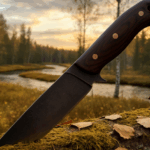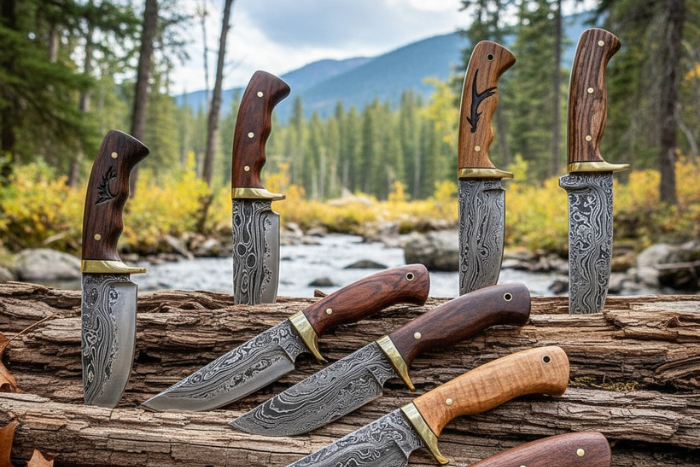

The auctioneer’s gavel fell with a sharp crack, and the room erupted in murmurs. A custom forged knife had just sold for $12,000 nearly triple its estimated value. I watched from the back of the auction house, fascinated by how a functional tool could command such prices. That moment sparked my journey into understanding knife collecting not just as a hobby, but as a legitimate investment strategy that combines passion with financial opportunity.
Knife collecting has evolved from a niche interest into a sophisticated market where discerning collectors recognize that custom knives represent both functional art and appreciating assets. Understanding what makes certain blades valuable, how to build a meaningful collection, and which factors drive appreciation can transform casual interest into strategic investment.
The foundation of knife collecting as investment begins with recognizing that not all knives appreciate equally. Mass-produced factory knives rarely gain significant value, while hand forged knives from respected makers consistently appreciate over time. The difference lies in craftsmanship, materials, maker reputation, and the inherent scarcity of individually crafted pieces.
Professional knife makers create limited numbers of blades each year, with each piece representing weeks or months of skilled labor. This natural scarcity creates the foundation for appreciation, particularly as a maker’s reputation grows. Early collectors who recognize talented craftsmen before they achieve widespread recognition often see the most dramatic returns on their investments.
The market for collectible knives has matured significantly over the past two decades. Online platforms, specialized auctions, and knife shows have created transparent pricing and connected collectors globally. This market development has brought legitimacy to knife collecting as an investment category, with documented price histories and established valuation methods.
Materials significantly impact collectible knife value. Blades forged from premium steel alloys particularly Damascus steel with distinctive patterns, or rare alloys like CPM-154 or S30V command higher prices. Handle materials also affect value, with exotic woods, mammoth ivory, stabilized burls, and precious metals increasing both aesthetic appeal and investment potential.
I learned this lesson when examining two similar hunting knives at a collector’s show. Both featured excellent craftsmanship and similar blade geometry, but one incorporated bog oak and Damascus steel while the other used standard carbon steel and synthetic handles. The price difference was substantial $800 versus $2,400 reflecting how materials directly influence collectible value.
Maker reputation represents perhaps the most critical factor in knife investment value. Established makers with decades of experience and recognition from organizations like the American Bladesmith Society command premium prices. Their work appreciates consistently as their reputation grows and production becomes increasingly limited.
Emerging makers present different investment opportunities. Identifying talented craftsmen early in their careers before widespread recognition drives prices higher offers potential for significant appreciation. This approach requires research, attending knife shows, following bladesmithing communities, and developing an eye for exceptional craftsmanship that may not yet command premium prices.
Condition and provenance dramatically affect collectible knife value. Knives maintained in pristine condition with original sheaths, documentation, and maker’s certificates retain maximum value. Provenance documented ownership history, particularly if previously owned by notable collectors or featured in publications can substantially increase value beyond the blade’s inherent qualities.
The investment timeline for collectible knives typically spans years or decades rather than months. Unlike stocks or bonds, knife collecting requires patience as maker reputations develop and scarcity increases. Collectors who purchase quality pieces and hold them long-term generally see the strongest returns.
Diversification within knife collecting follows similar principles to other investment categories. Building collections across multiple makers, styles, and price points reduces risk while maximizing appreciation potential. Some collectors focus on specific categories Bowie knives, folders, Damascus blades, or particular regional styles developing deep expertise that informs better purchasing decisions.
Authentication and verification become increasingly important as knife values rise. Reputable makers sign their work, often including date stamps and serial numbers. Documentation, photographs of the making process, and certificates of authenticity protect investment value and facilitate future sales.
I watched a collector friend purchase what appeared to be a valuable antique Bowie knife at an estate sale, only to discover through expert examination that it was a modern reproduction. The experience cost him $3,000 and taught the importance of verification before significant purchases.
Storage and preservation directly impact long-term investment value. Collectible knives require climate-controlled storage, protection from humidity and temperature fluctuations, and regular maintenance to prevent corrosion or deterioration. Proper storage preserves both aesthetic qualities and functional integrity that collectors value.
Insurance considerations become relevant as collection values grow. Specialized collectibles insurance protects against loss, theft, or damage, with policies specifically designed for knife collections. Documentation through photographs, appraisals, and detailed inventories supports insurance claims and establishes value for estate planning purposes.
The emotional component of knife collecting distinguishes it from purely financial investments. Collectors develop relationships with makers, appreciate the artistry and craftsmanship, and enjoy the functional beauty of their collections. This emotional connection sustains interest through market fluctuations and adds personal satisfaction beyond financial returns.
Market cycles affect knife collecting like other collectible categories. Economic downturns may temporarily depress prices, while periods of prosperity often see increased collector activity and rising values. Long-term collectors who maintain perspective through these cycles and avoid panic selling generally achieve the best investment outcomes.
Liquidity considerations differ from traditional investments. While established auction houses and online platforms facilitate sales, selling collectible knives typically takes longer than liquidating stocks or bonds. Collectors should view knife investments as long-term holdings rather than assets requiring quick liquidity.
Tax implications of knife collecting vary by jurisdiction and collection value. Significant collections may have estate tax implications, while profits from sales could generate capital gains obligations. Consulting with tax professionals familiar with collectibles ensures compliance and optimal tax treatment.
Building relationships within the collecting community provides access to knowledge, opportunities, and market insights that benefit investment outcomes. Knife shows, collector organizations, and online forums connect enthusiasts, facilitate trades, and create opportunities to purchase directly from makers before pieces reach the broader market.
The intersection of function and art makes knife collecting unique among investment categories. Unlike stamps or coins, quality knives remain functional tools that can be used and appreciated beyond their investment value. This dual nature practical utility and aesthetic beauty adds dimension to collecting that purely decorative collectibles lack.
Custom orders from respected makers represent another investment approach. Commissioning pieces directly allows input on design, materials, and features while establishing provenance from creation. As the maker’s reputation grows, these commissioned pieces often appreciate significantly.
Understanding market trends helps identify emerging opportunities. Current interest in Damascus steel, traditional forging techniques, and specific blade styles influences values. Collectors who recognize these trends early can position their collections to benefit from increasing demand.
The JWBS Knives approach to creating collectible blades combines traditional forging techniques, premium materials, and attention to detail that serious collectors value. Each piece receives individual attention, documentation, and the craftsmanship that transforms functional tools into investment-grade collectibles.
Starting a knife collection as investment doesn’t require massive capital. Beginning with quality pieces from emerging makers, learning continuously, and building expertise over time creates foundation for successful collecting. The key is purchasing quality over quantity, focusing on craftsmanship and materials that retain and appreciate in value.
Knife collecting as investment offers unique combination of tangible beauty, functional utility, and appreciation potential. For those willing to develop expertise, exercise patience, and appreciate fine craftsmanship, collectible knives provide both financial returns and personal satisfaction that few investment categories can match.
About JWBS Knives
JWBS Knives creates investment-quality hand forged knives combining traditional techniques with premium materials. Owner Joe Waldron’s commitment to exceptional craftsmanship produces collectible blades valued by discerning collectors and enthusiasts.
Contact JWBS Knives:
Ready to Start Your Collection? – Contact us today to discuss custom knife projects and investment-quality blades!
Join our newsletter and stay up to date on all the custom products jwbsknives has to offer and read about custom techniques we use in the Forging Process of your next Hand Crafted Knife and Accessories.
After order is placed we will contact you about shipping cost with your choice of carrier.